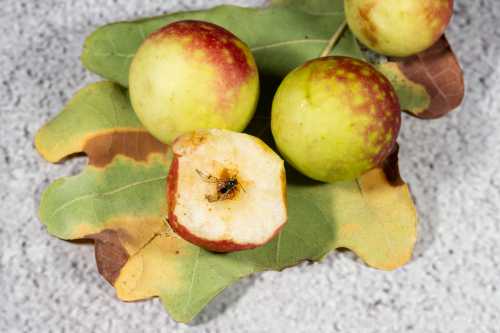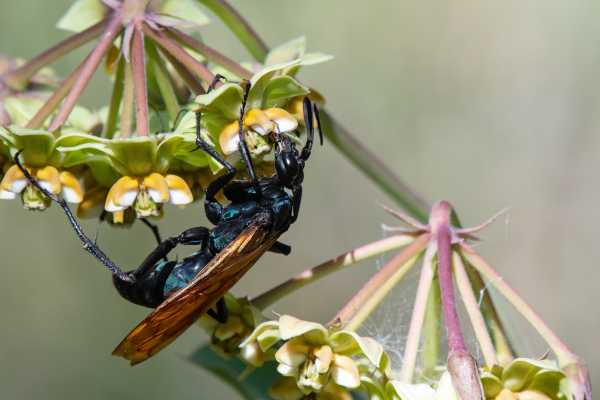Fig Wasps
Figs and pollinating fig wasps have a unique relationship where they depend on each other for pollination and reproduction.
But why should we care, and how do fig wasps pollinate figs? Read further to find out about the fig wasp!
What Are Fig Wasps?
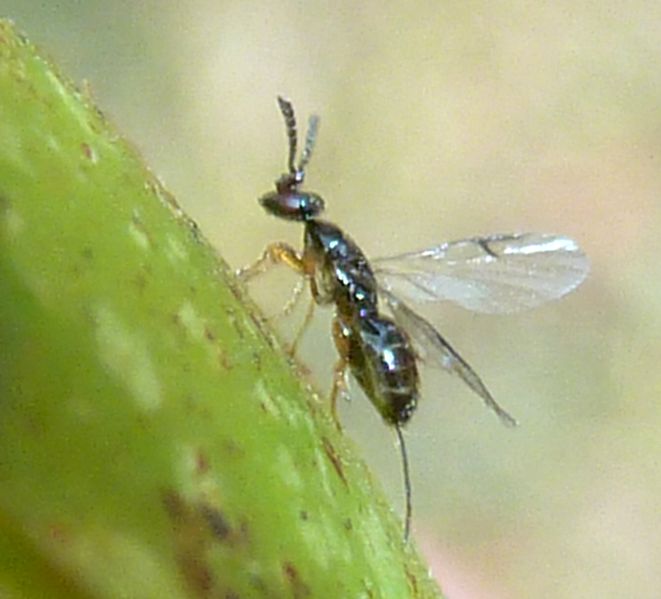 Fig wasp Ceratosolen capensis on Ficus sur in Jan Celliers Park, Pretoria
Source: JMC, Wikicommons - see Picture Credit in References section
Fig wasp Ceratosolen capensis on Ficus sur in Jan Celliers Park, Pretoria
Source: JMC, Wikicommons - see Picture Credit in References sectionFig wasps belong in the wasp family Agaonidae. These dark, tiny wasps typically range between 1 and 2 mm in length1. Females are larger than the males, which are wingless2.
Entomologist, Eric R Heaton1, describes fig wasps thus:
"While female fig wasps look like delicate fairies, the males resemble grotesque dragons, wingless or nearly so, wormlike, essentially blind with beefy legs and menacing jaws."
Fig wasps are mostly found in tropical Americas, Africa, Asia and Indo-Australian regions1.
What is the relationship between figs and fig wasps?
Why do figs need wasps?
In short, figs require pollinating wasps for pollination, while fig wasps require figs for survival.
Figs provide fig wasps with a protected environment in which to lay their eggs that will then develop inside the fig, while fig wasps ensure the pollination of fig flowers, enabling the tree to produce fig fruits.
This close interaction is an unusual example of what is called an 'obligate mutualism' between plants and gall-inducing insects2.
The fig-wasp mutualism is ancient and diverse, originating around 80-90 million years ago3.
However, it should be noted that many species of fig wasp are in fact parasitoids, providing no pollination benefit to the fig tree whatsoever. We'll cover the parasitoids later in this article.
Life cycle of the fig wasp
Figs have flowers concealed within a 'syconium' which is a fleshy, urn-shaped fruit.
A female fig wasp is attracted to the scented flowers inside the fig that are detectable thanks to a hole in the fruit called an ostiole1.
She enters the fruit via the ostiole, and lays her eggs. The wasp suffers wing damage and antennal breakage and consequently can usually visit only a single fig, and will soon die2.
Males are the first to hatch and will begin seeking out newly emerging females inside the fig, with which to mate.
After mating, the males help excavate a tunnel out of the fig for the females, who then fly off carrying both fig pollen and wasp eggs to a new host fig1. Upon entering the next fig, the female thus pollinates it. Meanwhile, the males remain inside the fig in which they were born, and will die after mating.
One interesting fact is that conflict can occur between male fig wasps when the number of females is limited within the fig.
Are fig wasps
inbred?
Yes, at least in some species, where males mate
with their female siblings inside the fig, thus leading to inbreeding.
However, in many species, there is mixed breeding resulting from multiple females laying eggs inside a single fig5.
How long do fig wasps live? What is the lifespan of a fig wasp?
Fig wasps live just 1 to 3 days2.
How do fig wasps pollinate figs?
As stated above, a fig is actually an urn-shaped structure called a syconium. The syconium contains within it, numerous male and female flowers.
Female fig wasps, laden with pollen from the flowers of the fig in which she was born, enters another fig through the narrow opening, known as the ostiole to get at its flowers.
She lays her eggs in some of the female flowers. Pollination occurs during this process.
Flowers containing wasp larvae form a gall-like structure which the new larvae will feed upon2. The pollinated flowers containing no larvae will produce seeds, which may be dispersed by other animals, birds and other vertebrates that eat the fig fruits, resulting in new fig trees1.
Newly emerging females will leave the fig, gathering pollen from the male flowers as they go, and will thus pollinate the next fig they visit, and the cycle begins again1.
This is the process in 'monoecious figs', where each fig contains both male and female flowers, but some fig species ('dioecious figs') produce male flowers on one tree, and female flowers on another1,6.
Do all figs need fig wasps for pollination? Which figs need wasps
Almost all wild fig varieties require fig wasps for pollination.
However, some commercial, landscape fig varieties are self-pollinating and do not need wasps.
Parasitic fig wasps
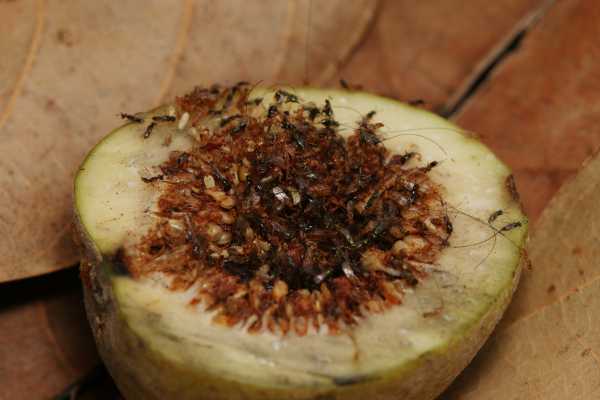 Fig wasps inside a fig. Parasitic species are identifiable by the long ovipositors
Fig wasps inside a fig. Parasitic species are identifiable by the long ovipositorsOther occupants of figs can include the non-pollinating parasitic gall-inducing wasps within the Sycophaginae (Agaonidae), Otitesellinae, and Epichrysomallinae (Pteromalidae) families2.
These are identifiable by their particularly long ovipositors which they use to pierce into the fig, and then inject their eggs inside.
The resulting parasitic offspring may eat the larvae of the pollinating wasps or their food (the flower ovary) thereby starving them. In these cases, the potential pollination process executed by the pollinating fig wasps, is disrupted.
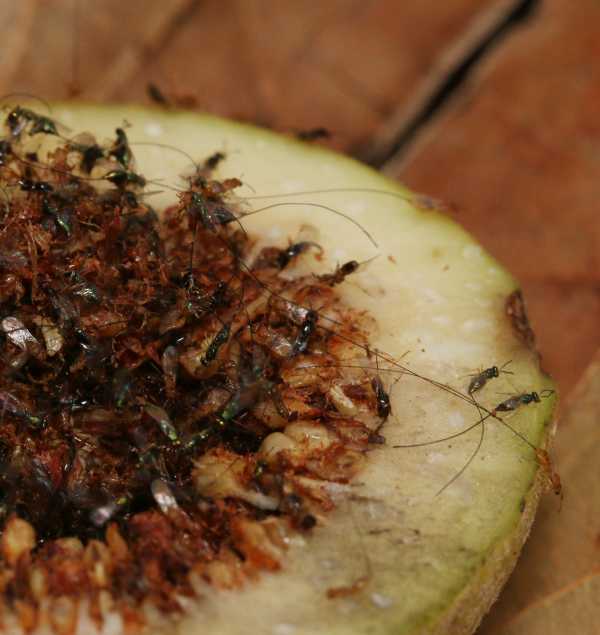 Close up of parasitic fig wasps inside a fig, with long ovipositors visible
Close up of parasitic fig wasps inside a fig, with long ovipositors visibleWhy do we need fig wasps?
Pollination by fig wasps results in fig fruits which are an essential food source.
Figs are eaten not only by humans. Over 1200 vertebrate species in 523 genera (including monkeys, birds, and bats) eat them too4, making figs a significant part of the animal ecosystem.
According to Eaton, fig fruits account for up to 70% of the diet of some tropical rainforest vertebrates1.
General questions about fig wasps:
Can fig wasps sting humans?
Due to their
small size (remember - no more than 2 mm!) fig wasps do not pose a threat to humans. Their stinger (ovipositor) is used for laying eggs.
What do fig wasps eat?
As larvae, fig wasps feed on the tissue within the flower where their mother laid her eggs.
Are there dead fig wasps inside figs, and am I eating dead fig wasps?
So having learned about the life cycle of fig wasps, you may be wondering whether you are likely to find yourself accidently eating wasps whilst you're eating a fig.
After all, given that males complete their life cycle inside the fig, and females entering to lay her eggs become injured and die shortly after, shouldn't there dead wasps in figs? Apparently not!
In fact, by the time you purchase figs to eat, there won't be any dead fig wasps inside the fruit. This is because the fig produces a digestive enzyme that dissolves the entire, tiny wasp before it gets near your plate. If there any crunchy bits inside the fig, that's the seeds!
This question is sometimes raised in relation to the vegan diet, however, the death of wasps inside a fig is a natural process with no human involvement.
References
Photo credit: Ceratosolen capensis on Ficus sur in Jan Celliers Park, Pretoria, by JMC; Attribution-ShareAlike 4.0 International, See: File:Ceratosolen capensis op Ficus sur, Jan Celliers Park, a.jpg - Wikimedia Commons
1. Eric R. Heaton; Wasps – The Astonishing Diversity Of A Misunderstood Insect, Princeton University Press 2021.
2. Borges Renee M. Interactions Between Figs and Gall-Inducing Fig Wasps: Adaptations, Constraints, and Unanswered Questions, Frontiers in Ecology and Evolution VOLUME 9, 2021, www.frontiersin.org/articles/10.3389/
fevo.2021.685542, DOI=10.3389/fevo.2021.685542, ISSN=2296-701X
3. C. A. Machado, N. Robbins, M. T. P. Gilbert, E. A. Herre, Critical review of host specificity and its coevolutionary implications in the fig / fig-wasp mutualism. Proc. Natl. Acad. Sci. U.S.A. 102 Suppl, 6558–6565 (2005).
4. Shanahan M, So S, Compton SG, Corlett R. Fig-eating by vertebrate frugivores: a global review. Biol Rev Camb Philos Soc. 2001 Nov;76(4):529-72. doi: 10.1017/s1464793101005760. PMID: 11762492.
5. Greeff, J., Jansen van Vuuren, G., Kryger, P. et al. Outbreeding and possibly inbreeding depression in a pollinating fig wasp with a mixed mating system. Heredity 102, 349–356 (2009). https://doi.org/10.1038/hdy.2009.2
6.Kerdelhué, Carole, and Jean-Yves Rasplus. “The Evolution of Dioecy among Ficus (Moraceae): An Alternative Hypothesis Involving Non-Pollinating Fig Wasp Pressure on the Fig-Pollinator Mutualism.” Oikos, vol. 77, no. 1, 1996, pp. 163–66. JSTOR, https://doi.org/10.2307/3545597. Accessed 26 Oct. 2023.
